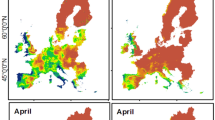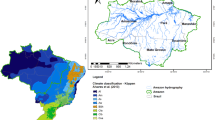Abstract
Intense rainfall events characterise the humid tropical small island develo** states (HuT-SIDS). Therefore, appropriate computation of rainfall erosivity is essential in predicting soil loss in the face of climate change. The rainfall erosivity index is calculated using kinetic energy and rainfall intensity of individual storm events requiring data that are often unavailable in HuT-SIDS. The objectives of our study were: (i) to investigate event-based rainfall erosivity using two erosive rainfall indices; and (ii) to create iso-erodent lines using Global Precipitation Measurement Integrated Multi-satellite Retrievals (GPM IMERG). We developed a Storm Event Tool (SE-TOOL) in the ArcGIS environment using Python scripts to automate the processing of sub-hourly precipitation data. The methodological approach integrated Python Scripts, Model Builder, geostatistical analytics and GPM IMERG data to calculate the erosivity indices, offering a novel approach to soil loss modelling. The results showed that the mean EI30 index, the product of total storm kinetic energy (E) and its maximum continuous 30-min intensity (I30), was 5080 MJ-mm-/ha-h. The Kinetic Energy greater than 25 mm (KE >25) index, recorded a mean erosivity of 1928 MJ/ha. The difference between the GPM IMERG and the Automated Weather Station was not significant (t (30) = 2.07; p < 0.05, 0.67). EI30 was determined to be the more appropriate erosivity index for predicting soil loss in the HuT-SIDS. The integration of higher temporal and spatial resolution data and including all storm events above the 0 mm threshold, increased the model accuracy, providing baseline data for soil erosion risk assessment.








Similar content being viewed by others
References
Agnese C, Bagarello V, Corrao C, D’Agostino L, D’Asaro F (2006) Influence of the rainfall measurement interval on the erosivity determinations in the Mediterranean area. J Hydrol 329(1–2):39–48. https://doi.org/10.1016/j.jhydrol.2006.02.002
Beguería S, Serrano-Notivoli R, Tomas-Burguera M (2018) Computation of rainfall erosivity from daily precipitation amounts. Sci Total Environ 637-638:359–373. https://doi.org/10.1016/j.scitotenv.2018.04.400
Bisson R (2002) Hydrogeological reassessment of Trinidad. Trinidad and Tobago
Bobrowsky PT (2013) Encyclopedia of Natural Hazards, vol 1135. Springer, Dordrecht
Curtis S, Gamble DW (2008) Regional variations of the Caribbean mid-summer drought. Theor Appl Climatol 94(1):25–34. https://doi.org/10.1007/s00704-007-0342-0
de Lima CA, de Q Palácio HA, de Andrade EM, dos Santos JCN, Brasil PP (2013) Characteristics of rainfall and erosion under natural conditions of land use in semiarid regions. Revista Brasileira de Engenharia Agrícola e Ambiental 17(11):1222–1229. https://doi.org/10.1590/S1415-43662013001100014
Diodato N, Guerriero L, Bellocchi G (2017) Modeling and upscaling plot-scale soil erosion under Mediterranean climate variability. Environments 4(3):58. https://doi.org/10.3390/environments4030058
Elwell HA, Stocking MA (1973) Rainfall parameters for soil loss estimation in a subtropical climate. J Agric Eng Res 18:169–177
Fernandez H, Martins F, Isidoro J (2018) Using the modified Fournier index to model rainfall aggressiveness with scarce rainfall data. EGU General Assembly Conference Abstracts
Gheuens J, Nagabhatla N, Perera EDP (2019) Disaster-risk, water security challenges and strategies in Small Island develo** states (SIDS). Water 11(4):637. https://doi.org/10.3390/w11040637
Gonçalves FA, da Silva DD, Pruski FF, de Carvalho DF, da Cruz ES (2006) Índices e espacialização da erosividade das chuvas para o Estado do Rio de Janeiro. Revista Brasileira de Engenharia Agrícola e Ambiental 10:269–276. https://doi.org/10.1590/S1415-43662006000200004
Guo D (2010) Local entropy map: a nonparametric approach to detecting spatially varying multivariate relationships. Int J Geogr Inf Sci 24(9):1367–1389. https://doi.org/10.1080/13658811003619143
Hill MH (2010) Isopleth maps. In: Encyclopedia of geography. SAGE Publications, Inc., Thousand Oaks, CA, pp 1639–1639
Hudson N (1976) Research needs for soil conservation in develo** countries. In: Soil conservation and Management in Develo** Countires. Food and Agriculture Organisation of the United Nations, Rome, pp 169–184
Huffman G (2015) GPM IMERG late precipitation L3 half hourly 0.1 degree x 0.1 degree V05. Edited by Goddard earth sciences data and information services center (GES DISC). Greenbelt, MD: EARTHDATA
Huffman GJ, Bolvin DT, Nelkin EJ, Stocker EF, Tan J (2019) V06 IMERG Release Notes
Lal R (1976) Soil erosion on Alfisols in Western Nigeria: effects of rainfall characteristics. Geoderma 16(5):389–401. https://doi.org/10.1016/0016-7061(76)90003-3
Lal R (1985) Soil erosion and sediment transport research in tropical Africa. Hydrol Sci J 30(2):239–256. https://doi.org/10.1080/02626668509490987
Lee M-H, Lin H-H (2015) Evaluation of annual rainfall Erosivity index based on daily, monthly, and annual precipitation data of Rainfall Station network in southern Taiwan. International Journal of Distributed Sensor Networks 11(6):214708. https://doi.org/10.1155/2015/214708
Lindsay JI (2008) Rainfall erosivity, soil erodibility and soil loss studies under different managements at two sites in Trinidad (Doctoral dissertation)
Llasat M-C (2001) An objective classification of rainfall events on the basis of their convective features: application to rainfall intensity in the northeast of Spain. International Journal of Climatology: A Journal of the Royal Meteorological Society 21(11):1385–1400. https://doi.org/10.1002/joc.692
McLean NM, Stephenson TS, Taylor MA, Campbell JD (2015) Characterization of future Caribbean rainfall and temperature extremes across rainfall zones. Adv Meteorol 2015:425987–425918. https://doi.org/10.1155/2015/425987
Melville T, Sutherland M, Wuddivira MN (2020) Assessing trends and predicting the cover management factor in a tropical island state using enhanced vegetation index. SN Appl Sci 2(10):1–14. https://doi.org/10.1007/s42452-020-03482-8
Nearing MA, Yin S, Borelli P, Polyakov VO. (2017) Rainfall erosivity: An historical review. CATENA 157357-362 https://doi.org/10.1016/j.catena.2017.06.004
Renard KG, Foster GR, Weesies GA, McCool DK, Yoder DC (1997) Predicting soil erosion by water: a guide to conservation planning with the revised universal soil loss equation (RUSLE), vol 703. Agricultural Research Service, Washington, DC
Sem G (2007) Vulnerability and adaptation to climate change in small island develo** states. United Nations Development Programme, New York
Staub CG, Stevens FR, Waylen PR (2014) The geography of rainfall in Mauritius: modelling the relationship between annual and monthly rainfall and landscape characteristics on a small volcanic island. Appl Geogr 54:222–234. https://doi.org/10.1016/j.apgeog.2014.08.008
Stephenson TS, Vincent LA, Allen T, Van Meerbeeck CJ, McLean N, Peterson TC, Taylor MA, Aaron-Morrison AP, Auguste T, Bernard D, Boekhoudt JRI, Blenman RC, Braithwaite GC, Brown G, Butler M, Cumberbatch CJM, Etienne-Leblanc S, Lake DE, Martin DE et al (2014) Changes in extreme temperature and precipitation in the Caribbean region, 1961–2010. Int J Climatol 34(9):2957–2971. https://doi.org/10.1002/joc.3889
Stocking MA, Elwell HA (1976) Rainfall erosivity over Rhodesia. Trans Inst Br Geogr 1:231–245. https://doi.org/10.2307/621986
Sukhanovskii YP (2007) Modification of a rainfall simulation procedure at runoff plots for soil erosion investigation. Eurasian Soil Science 40(2):195–202. https://doi.org/10.1134/S106422930702010X
Taylor MA, Enfield DB, Chen AA (2002) Influence of the tropical Atlantic versus the tropical Pacific on Caribbean rainfall. Journal of Geophysical Research: Oceans 107(C9):10–1–10-14
TTMS (2018) Trinidad and Tobago climate. Trinidad and Tobago Meteorological Service, accessed August 4 2018. https://www.metoffice.gov.tt/climate_daily_data
Vantas K, Sidiropoulos E, Evangelides C (2019) Rainfall erosivity and its estimation: conventional and machine learning methods. In: Soil Erosion-Rainfall Erosivity and Risk Assessment. IntechOpen
Wischmeier WH (1959) A rainfall Erosion index for a universal soil-loss equation. Soil Sci Soc Am J 23(3):246–249. https://doi.org/10.2136/sssaj1959.03615995002300030027x
Wischmeier WH, Smith DD (1978) Predicting rainfall erosion losses : a guide to conservation planning, agricultural handbook 537. United States Department of Agriculture, Washington DC
Yin S, Nearing MA, Borrelli P, Xue X (2017) Rainfall Erosivity: an overview of methodologies and applications. Vadose Zone J 16(12). https://doi.org/10.2136/vzj2017.06.0131
Zhang Y, Fueglistaler S (2019) Mechanism for increasing tropical rainfall unevenness with global warming. Geophys Res Lett 46(24):14836–14843. https://doi.org/10.1029/2019GL086058
Zhao W, Bojie F, Yang Q (2013) An upscaling method for cover-management factor and its application in the loess plateau of China. Int J Environ Res Public Health 10(10):4752–4766. https://doi.org/10.3390/ijerph10104752
Zheng M, Chen X (2015) Statistical determination of rainfall-runoff erosivity indices for single storms in the Chinese loess plateau. PLoS One 10(3). https://doi.org/10.1371/journal.pone.0117989
Acknowledgements
The first author would like to acknowledge The University of the West Indies, St. Augustine, to provide technical support during the research. Thanks to Bryan Smith and Rojar Ojar for their encouragement and support for this research study. The authors are also thankful to the anonymous reviewers and editors for their constructive comments and suggestions, which significantly improved the quality of the manuscript.
Availability of data and material
The datasets generated during and/or analysed during the current study are available from the corresponding author on reasonable request.
Code availability
The codes generated during and/or analysed during the current study are available from the corresponding author on reasonable request.
Author information
Authors and Affiliations
Corresponding author
Ethics declarations
Conflict of interest
The authors have no conflicts of interest to declare that are relevant to this article’s content.
Additional information
Communicated by: H. Babaie
Publisher’s note
Springer Nature remains neutral with regard to jurisdictional claims in published maps and institutional affiliations.
Rights and permissions
About this article
Cite this article
Melville, T., Wuddivira, M. & Sutherland, M. Geospatial modelling of rainfall erosivity in the humid tropics using remotely sensed data. Earth Sci Inform 15, 891–904 (2022). https://doi.org/10.1007/s12145-022-00773-z
Received:
Accepted:
Published:
Issue Date:
DOI: https://doi.org/10.1007/s12145-022-00773-z




